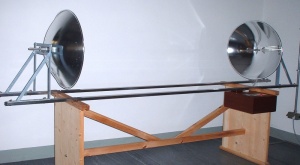Burning mirrors
| Burning mirrors | |
|---|---|

| |
| On display at | Il Giardino di Archimede |
| Type | Hands-on |
| Topics | geometry, conic sections, mirrors, history |
This exhibit is part of the exhibition Beyond the compass at Il Giardino di Archimede.
Contents
Description
The exhibit consists of a pair of parabolic mirrors, making a set of indoor "burning mirrors". Solar rays are substituted with those from a halogen lamp. The lamp is located in the focus of a first parabolic mirror, from which the light rays are reflected and come out parallel to the axis. A second reflection on the second mirror concentrate the light rays again on the focus of this second mirror.
Turning on the lamp, the heat generated by the bulb put in the focus of one mirror manages to light a match in the focus of the other.
The parabolic mirrors can be found in the specialized market, the rest of the structure is usual workshop task.
Activities and user interaction
A mediator is always present to conduct the demonstration. The mediator puts a match in the focus of the second mirror, lights the lamp and the audience waits a few seconds for the match to be burnt. An explanation follows.
The lighting of the match makes the properties of paraboloids clear and visible: this fact stimulates the visitor’s wonder and curiosity, beyond the strengthening of the concept.
Background
A tradition dating back to Plutarch says that Archimedes invented the mirrors with which set fire to the Roman ships besieging the city of Syracuse. How they built these mirrors Plutarch does not say.
The simplest form of a burning mirror is that of a paraboloid of rotation, a surface that is generated by rotating a parabola around to its axis. In a parabola there exists a point F, called focus, with the properties that rays parallel to the axis concentrate in the focus.
This property of the parabola can be used to build a mirror that concentrates solar rays (which we may consider parallel because of the great distance of the Sun) in the focus, where they can light up inflammable materials.
History and museology
This exhibit is part of a series about conics sections in the main exhibition Beyond the compass, at Giardino di Archimede. It is particularly connected with an exhibit on the paraboloid obtained from the rotation of a parabola and with an exhibit on the sound parabolas. Other exhibits concern the focal properties of the ellipse and the ellipsoid.
This exhibit was part of the seminal experience in 1991 by Prof. Franco Conti and Prof. Enrico Giusti, even before the Giardino was conceived.